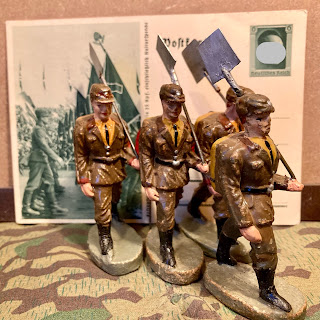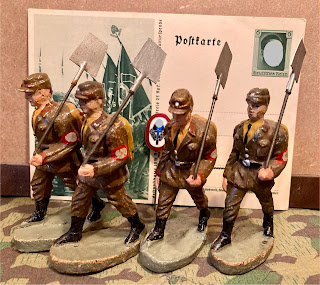Premium Flexible Related Post Widget for Blogger – Blogspot
Sunday, June 29, 2025
WW2 German Toy Lazarett with Tippco Ambulance 🏥🏥🏥👨⚕️👩⚕️🧑⚕️🚑🚑🚑⚕️⚕️⚕️
This layout depicts a German WW2 field hospital ("Lazarett") using 1930s composition figures from various makers including Lineol, Elastolin, Schusso, Kienel, and Durso (Belgium). The centerpiece is a wind-up tinplate Tippco ambulance (Nr. 914) in camouflage livery. The scene includes wounded soldiers, nurses, stretcher teams, and even a few Red Cross dogs, arranged around a makeshift bunker.
Thursday, June 26, 2025
Rare Export: French Version of a German Toy Bunker 🇫🇷🇫🇷🇫🇷🏰🏰🏰
This rare wooden fortification model was produced in Germany (Hausser/ Elastolin or Moritz Gottschalk ?) in the early 1930s and exported to France, likely inspired by the then-newly constructed Maginot Line. It features a concrete-style bunker with twin rotating turrets, trench system with barbed wire entanglements, and French signage such as "Poste de Secours" and "G.Q.G."(Grand Quartier Général).Some time ago I saw also the English version of this model.Constructed from painted wood and plaster in muted tones, this model stands out for its unique configuration and historical significance as a reflection of interwar military anxieties. A seldom-seen piece of early 20th-century toy history. To enhance the scene, I’ve added Elastolin French army figures in horizon blue uniforms, bringing the fortification model to life.I once came across an English version of this same model, which featured signs like “GHQ” and “Safety Zone” — further evidence thatthese forts were adapted for different international markets during the interwar years.
Tuesday, June 24, 2025
Lineol Catalog 1932
This Lineol Catalog 1932 contains 6 pages of composition soldiers and timplate military vehicles produced by Lineol (Germany). True-to-life models • Beautiful painting • Almost unbreakable.
The catalog is avaliable here (6 pages, pdf, 4.6 Mb):
Labels:
catalog,
composittion soldiers,
eusoldatini,
Germany,
Lineol,
WW2
Sunday, June 22, 2025
Deutsche Vergangenheit und deutsche Zukunft 🐎🐎🐎⚔️⚔️⚔️📕📕📕
"Deutsche Vergangenheit und deutsche Zukunft" – Postcard by Karl Alex Wilke (c. 1910).
This patriotic postcard by Karl Alex Wilke, issued around 1910, depicts a contemplative boy reading a large book while ghostly German cavalry ride in the background, symbolizing the link between historical memory and national identity.
Labels:
book,
boy,
cavalry,
eusoldatini,
Germany,
Karl Alex Wilke,
Knights,
Medieval,
Postcard,
reading
Saturday, June 21, 2025
Friday, June 20, 2025
Toy soldiers from Latvia 🇱🇻🇱🇻🇱🇻
This set of plastic toy soldiers represents the USSR army and was produced by Straume factory (Riga, Latvia) in 70s.It seems that these soldiers were produced with home cast moulds from Schneider (Germany).
Wednesday, June 18, 2025
Kienel RAD soldiers
This 1930s Kienel set features four 70 mm composition RAD soldiers marching with metal shovels. Unmarked and dressed in standard RAD uniforms, they reflect Kienel’s typical “farm-boy” aesthetic.
Labels:
eusoldatini,
Kienel,
RAD,
Reichsarbeitsdienst,
shovel,
WW2
Saturday, June 14, 2025
Lineol Heer Kraftradschutzen Models 🏍️🏍️🏍️
These two Lineol Heer Kraftradschützen (motorcycle troops) models were produced between 1934 and 1939 and depict German military motorcyclists of the period. Model (5/212) includes a motorcyclist with a sidecar carrying an officer, while (5/213M) features a sidecar mounted with a submachine gun and an additional carriage. Both have moveable wheels and reflect the focus on mobility in the German army during the 1930s. These miniatures are now of interest to collectors for their historical context and mechanical design.
Labels:
bike,
BMW,
eusoldatini,
Heer,
Kraftradschützen,
Lineol,
motorbike,
motorcycle,
World War 2
Saturday, June 7, 2025
Alte Kameraden
This striking set of 70mm marching soldiers, each with rifles shouldered, was produced by Elastolin (Germany) between 1939 and 1941. The figures are clad in tunics with six-button detailing, capturing the precise military aesthetic of the era.
To bring these composition figures to life, I’ve added a video created with PixVerse AI.
Labels:
AI,
Elastolin,
eusoldatini,
infantry,
PixVerse AI,
Wehrmacht,
World War 2,
WW2
Friday, June 6, 2025
Elastolin national socialists 🗞️📰🗞️📰🗞️📰🗞️
The article from the Oberbergischer Bote (23 May 1938), a Nazi Party-affiliated newspaper, criticizes the commercialization and trivialization of National Socialist symbols through children's toys and consumer goods. It specifically targets the company Hausser, which produced Elastolin toy figures of Nazi leaders such as Hitler, Goebbels, and Göring. These figures, once detailed in the 1937 catalog—including controversial items like a "Blood Flag" bearer—were deemed offensive and labeled as national kitsch (nationalist tackiness).
The article acknowledges that by 1938, the worst of these items had been removed from the catalog, but still disapproves of the general concept of turning National Socialist figures into toys. It frames this practice as profiteering and an insult to the dignity of the Nazi cause.
The article further supports its stance by quoting a letter from a party member who disapproves of Nazi slogans appearing on products like coal briquettes during election campaigns. The author agrees, stating that not everything should be permissible in the name of propaganda or goodwill, and calls for public vigilance and rejection of such commercialization.
In summary, the piece is a propaganda-driven denunciation of the commodification of Nazi imagery, appealing to party loyalty and public morality to curb what it sees as disrespectful and tasteless uses of political symbols.
Full text of this article in English is available here:
Wednesday, June 4, 2025
Hausser/Elastolin Wooden Military Fort – Model 13492 (c.1935) 🇾🇪🇾🇪🇾🇪🏰🏰🏰
A rare and finely crafted example of pre-WWII German toy manufacturing, this wooden military fort is Model 13492 from the Hausser/Elastolin catalog, produced circa 1935. Designed with true-to-life detail, the fort features a square layout with Laufgraben (communication trenches), two tinplate flags, dual watch stands, and a rotating armored dome. It is also equipped with three gun barrels accommodating both kneeling and standing figures. Measuring approximately 36 x 27 x 17 cm, this model exemplifies the realism and craftsmanship typical of Elastolin's 1930s production. Rarely found in such complete condition today, it remains a sought-after piece among collectors of vintage composition soldiers.
Labels:
artillery,
composite soldiers,
Deutschland,
Elastolin,
eusoldatini,
fort,
fortress,
Germany,
Hausser,
WW2
Monday, June 2, 2025
WWI Brits by Durolin, Germany 🇬🇧🇬🇧🇬🇧💥💥💥
These two WWI British Army attacking toy soldiers were made by Durolin in 1930s Germany. I’ve also added a short video of the figures, created with PixVerse AI, to bring them to life.
Labels:
AI,
attack,
British Army,
Durolin,
eusoldatini,
eusoldatini.,
PixVerse AI,
WW1
Sunday, June 1, 2025
WW2 postcard - Kleiner Soldat mit Stahlhelm .🪖🪖🪖🗡️🗡️🗡️🇾🇪🇾🇪🇾🇪
Artist-signed postcard by Fr. Bertram issued during the WWII era.
Caption: “The God who let iron grow did not want servants.”("Der Gott der Eisen wachsen ließ, der wollte keine Knechte").
Depicts a small child dressed as a soldier, wearing a steel helmet. The phrase is a patriotic line originally from the 19th-century German poem “Das Lied vom deutschen Vaterland” by Ernst Moritz Arndt, often used in nationalist contexts.
Saturday, May 31, 2025
Durso Toy Soldiers: Tribute to the Chasseurs Ardennais 🇧🇪🇧🇪🇧🇪⛰️⛰️⛰️🌲🌲🌲
The Bataillon de Chasseurs Ardennais, formed in 1933, was tasked with defending Belgium’s Luxembourg Province and the Ardennes region. Renowned for their resistance during the German invasion in 1940, these troops became national symbols of courage.
In the 1940s and 1950s, Belgian toymaker Durso, founded by Russian émigré Michel Klimov, produced finely crafted composition soldiers honoring Belgium’s military history. Among them is the figure 1177, showing two ambulance men carrying a wounded Chasseur Ardennais—a moving scene that reflects both bravery and compassion.
Friday, May 23, 2025
German WW 2 postcard "Steh ich in finstrer MItternacht" 🌙🌛🌝🌚
Labels:
boy,
Deutschland,
euslodatini,
Postcard,
World War 2,
WW2
Sunday, May 18, 2025
Automaton in the Shape of a Galley ⛵️⛵️⛵️
Kunsthistorisches Museum, Vienna (Austria)
This remarkable automaton, shaped like a war galley, is both a technical marvel and a masterpiece of craftsmanship. Hidden within its intricately carved hull lies a mechanical engine that once powered the ship to roll across banquet tables while chained convicts rhythmically rowed—bringing the scene to life with mesmerizing precision.
Every detail of the galley and its crew was painstakingly crafted using ivory, brass, iron, linen, and silk. The automaton is the collaborative work of two master ivory turners and a skilled clockmaker from Stuttgart: Georg Burrer, Georg Ernst, and Christoph Schorkfel. Their names, preserved on a contemporary parchment note hidden within the ship, bear witness to the legacy of early 17th-century mechanical ingenuity and decorative art.
📏 Dimensions: 51.5 cm × 84 cm × 33.5 cm
🛠 Materials: Ivory, brass, linen, silk, iron
📅 Created: Circa early 1600s, Stuttgart
Saturday, May 17, 2025
Elastolin Composition Figure of Hermann Göring 🌬️🌬️🌬️💨💨💨🛩️🛩️🛩️
This historically significant composition figure represents Hermann Göring (1893–1946), a prominent figure in Nazi Germany, known as a military leader, aviator, and high-ranking Nazi official. While his legacy is one of criminality and infamy, his representation in toy soldier form reflects the historical production trends of 1930s Germany.
The figure was manufactured by Elastolin and featured in their 1939/40 catalog under number 26/21. It is notable for its porcelain head and movable arm, exemplifying Elastolin’s brief production period of high-detail personality figures. Elastolin began incorporating porcelain heads into its composition figures in 1936, aiming to achieve more lifelike and expressive facial features.
These porcelain heads were produced separately by the renowned German porcelain maker Hertwig & Co. (Hertwig Katzhütte) of Thuringia, known for their craftsmanship and fine detail.
Thursday, May 15, 2025
Sunday, May 11, 2025
Normandy Bunker 🏰🏰🏰
This wooden bunker has been attributed to Lehmann LGB of Nuremberg. While the craftsmanship is impressive, I remain somewhat skeptical about its actual Lehmann origin. I've included several photos of the bunker alongside Lineol and Elastolin composition soldiers for scale and context. The tinplate VW-82 Kübelwagen featured in the scene was manufactured by Gonio (Czech Republic) in the 1990s.
Labels:
Atlantic Wall,
bunker,
Elastolin,
eusoldatini,
Gonio,
Kubelwagen,
Lehmann,
Lineol,
Normandy,
Nuremberg,
VW-82,
World War 2,
WW2
Subscribe to:
Posts (Atom)





















































